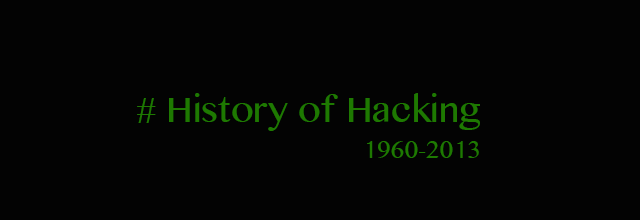
History of Hacking
The whistleblower WikiLeaks is the hot fuzz goosing over the internet. So, how this anonymous site gained a sound alarm of the tech geeks around the globe, thanks to Hacking for lending an indirect impact on this. Let’s see now what actually hacking is. Hacking is not limited to computers. The real meaning of hacking is to expand the capabilities of any electronic device; to use them beyond the original intentions of the manufacturer. As a matter of fact, the first hackers appeared in the 1960’s at the Massachusetts Institute of Technology (MIT), and their first victims were electric trains. They wanted them to perform faster and more efficiently. So, is hacking always bad? Not really. It only depends on how we use it. But it wasn’t until a group of these hackers decided to exert their knowledge in the computer mainframes of the MIT.
During the 1970’s, a different kind of hacker appeared: the phreaks or phone hackers. They learned ways to hack the telephonic system and make phone calls for free. Within these group of people, a phreaker became famous because a simple discovery. John Draper, also known as Captain Crunch, found that he could make long distance calls with a whistle. He built a blue box that could do this and the Esquire magazine published an article on how to build them. Fascinated by this discovery, two kids, Steve Wozniak and Steve Jobs, decided to sell these blue boxes, starting a business friendship which resulted to the foundation of Apple.
By the 1980’s, phreaks started to migrate to computers, and the first Bulletin Board Systems (BBS) appeared. BBS are like the yahoo groups today, where people posted messages of any kind. The BBS used by hackers specialized in tips on how to break into computers, how to use stolen credit card numbers and share stolen computer passwords.
It wasn’t until 1986 that the US government realized the danger that hackers represented to the national security. As a way to counteract this menace, the Congress passed the Computer Fraud and Abuse Act, making computer breaking a crime across the nation.
During the 1990’s, when the use of the internet widespread around the world, hackers multiplied, but it wasn’t until the end of the decade that system’s security became mainstream among the public.
Today, we are accustomed to hackers, crackers, viruses, Trojans, worms and all of the techniques we need to follow to combat them.
Timeline of Hacking
1960: The first computer hackers emerged at MIT. They borrow their name from a term to describe members of a model train group at the school who “hack” the electric trains to make them perform faster and differently.
1971: Phone Phreaking: John Draper is nicknamed ‘Cap’n Crunch’ after he learns that a toy whistle given away inside cap n crunch creal generates a 2600 hartz signal, the same sigh-pitched tone that accesses AT&T’s Long distance switching system allowing him to make free long distance calls.
1983: The FBI busts six teen age hackers from Mil-waukee, known as the 414s after the local area code. The hackers are accused of some 60 computer break-ins, Including the memorial sloan-kettering cancer and Los Alamos national laboratory. One of the hackers gets immunity for his testimony; the other five get probation.
1983: The movie “war games” introduces the public to hacking and the legend of hackers as cyber heroes and anti-heroes is born. The film main character played by Mathew Broderick attempts to crack into a video game manufacture’s computer to play a game but instead breaks into the military’s nuclear combat simulator computer.
1984: Eric Corly, who uses the hacking handle “Emmanuel Goldstein”, starts 2600: The hackers quarterly in New York, which quickly becomes a clearing house for information.
1987: 17years old high school dropout, Herbert zinn, known to authorities as “shadow hawk” admits he broke into AT&T computers at Bedminster, N.J.Zinn become one of the first people prosecuted under the computer fraud and abuse act of 1986, which among other things makes it illegal to use another person’s password.
1988: Robert Tappan Morris Junior, a graduate student at Cornell University launches a self-replicating worm on the government’s Arpanet to test its effect on UNIX systems. The worm gets out of hand and spreads to some 6000 networked computers, clogging government and university system. Morris is rusticated from Cornell, sentenced to three years of probation and fined $10,000.
1989: Kevin Mitnick is convicted of stealing software from DEC and long -distance codes from MCI, becoming the first person convicted under a new law against gaining access to an interstate computer network for criminal purposes.
1990: The Secret Service launches “operation Sun devil” to hunt down hackers. Agents eventually seize computer equipment in 14 cities.
1991: The General Accounting office reveals that Dutch teenagers gained access to defense department computers during the Persian Gulf War, changing or copying unclassified sensitive information related towar operations, including data on military personnel, the amount of military equipment being moved to the gulf and the development of important weapons systems.
1994: Two hackers identified as “Data Stream” and “Kuji” break into Griffith air force base and hundreds of other systems, including computers at NASA and the Korean atomic research institute. After a cyber- manhunt, Scotland Yard detectives arrest “Data Stream”, a 16years old British teenager who curls up in the fetal position and cries when seized. “Kuji” is never found.
1996: A hacker who goes by the handle jenny mail bomber about 40 politicians, business leaders and other individuals and institutions by subscribing them to internet mailing lists, generating as many as 20,000 messages in one weekend. He also publishes a manifesto explaining why he selected each target. He is never caught.
1998: Deputy Defense secretary john hamre announces that hackers have carried out “the most organized and systematic attack the pentagon had seen to date.” Two teenagers from Cloverdale, California are detained in connection with the break-ins and an Israeli teenager known as “the analyzer” is arrested as the alleged mastermind of the intrusion.
1998: Anti hackers ad runs during super bowl XXXII. The network associates ad, costing$1.3 million for 30seconds, show two Russian missile silo crewmen worrying that a computer order to launch missiles may have come from a hacker. They decide to blow up the world any ways.
1999: Norwegian group masters of reverse engineering (More) cracks a key to decoding DVD copy protection. The group creates a DVD decoder program for distribution on the Web, a move that spurs a flurry of lawsuits from the entertainment industry.
2000: In a three day period, hackers brought down leasing websites including yahoo!, Amazon.com, Buy.com, eBay and CNN.com using “Denial of Service” attacks that overloaded that sites servers with an inordinate number of data requests.
2000: After 9 million hack attempts security website Anti-Online is defaced by Australian hacker ‘ron1n’. Anti-Online was deemed “unhackable” by the sites owner, john vranesvich, but a poorly coded cgi scripts written by vransevichd led to the hack.
2000: More than 55,000 credit card numbers were stolen from creditcards.com, which processes credit transactions for online companies. About 25,000 of them were posted online when an extortion payment was not made.
2001: US authorities claim that Gary McKinnon, from Glasgow, Scotland, deleted critical files from operating systems, which shut down the US army’s Military district of Washington network of 2,000 computers for 24hours, as well as deleting US navy weapons logs rendering a naval base’s network of 300 computers inoperable after the September 11th terrorist attacks.
2001: LA times reports that hackers attacked a computer system that controls much of the flow of electricity across California’s power grid for 17days or more during the state’s worst days of the power crisis. The attack appears to have originated in china’s Guangdong province and caused considerable concern among state and federal bureaucrats.
2002: A 17years old female hacker from Belgium calling herself “Gigabyte” takes credit for writing the first ever virus written in Microsoft’s newest programming language C#.
2002: Lisa Chen a 52 year old Taiwanese woman who pleaded no contest in one of the largest software piracy cases in the U.S was sentenced to nine years in prison, one of the longest sentences ever for a case involving software piracy. Chen was arrested in November 2001 after local sheriffs seized hundreds of thousands of copies of pirated software smuggled from Taiwan with as estimated worth above $75million.
2006: Jeanson James Ancheta receives a 57month prison sentence and is ordered to pay damages amounting to $15,000 to the naval air warfare center in China Lake and the defense information system agency for damage done due to ddos attacks and hacking. Ancheta also had to forfeit his gains to the government, which include $60,000 in cash, a BMW and computer equipment.
2007: The UN website is defaced by Turkish hacker. The speeches of the secretary general ban Ki moon were replaced with some other text.
2008: The conficker worn is first detected by January 2009 there are an estimated 15 million computers infected with the worm. February 13 2009, Microsoft offers a $250,000 reward for information leading to the arrest and conviction of the individuals behind the creation and /or distribution of conficker.
2008: A group of men use war driving a method of searching for unsecured wireless networks by driving around with a laptop to install sniffer programs that stole over 40 million credit card numbers in one of the largest known cases of credit card fraud in US history.
2009: The first iPhone worm appeared in early November 2009, created by 21-year-old Australian technical college student Ashley Towns of Wollongong. He told Australian media that he created the worm to raise awareness of security issues.
2010: A group of hackers exploited a hole in an AT&T Web site to get e-mail addresses of about 114,000 iPad users, including what appear to be top officials in government, finance, media, technology, and military.
2011: Sony Playstation announced its network and Qriocity had both been compromised by hackers between April 17 and April 19 allowing access to 70 million user accounts.
2011: Google announced that the gmail accounts of select members of the U.S. Government had been compromised by Chinese hackers.
2012: Hackers breached a network belonging to the Indian intelligence service and acquired a vast amount of Symantec’s Norton anti-virus source code. It was subsequently posted on Pastebin, often used by hackers to post leak data and source code anonymously.
2012: MasterCard and Visa customers were warned after a massive data breach that affected more than 1.5 million credit and debit card owners. While a hacker initially claimed responsibility for the data breach.
2013: Anonymous strikes on the US Federal Reserve bank confirmed that over 4,000 bank executives had their details stolen when Anonymous hacked one of their internal websites. Anonymous published the login information, IP addresses, contact information and credentials of over 4,000 US Federal Reserve employees in a campaign coined by Anonymous as OpLastResort.







